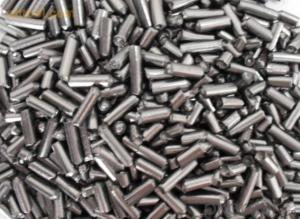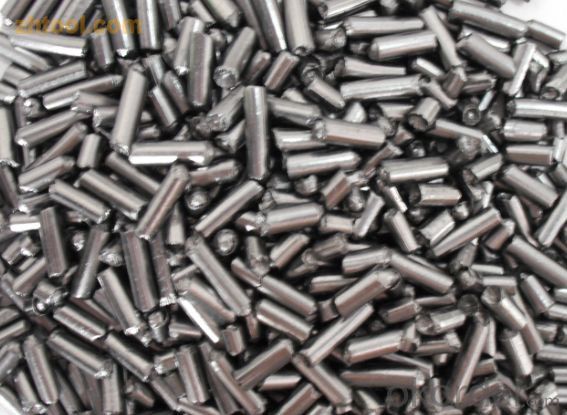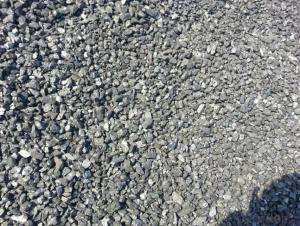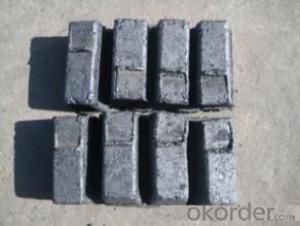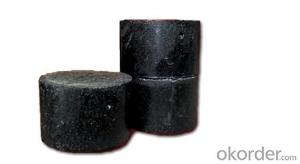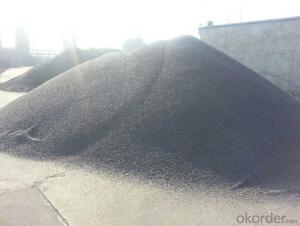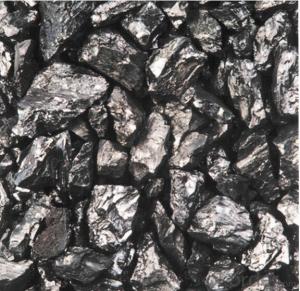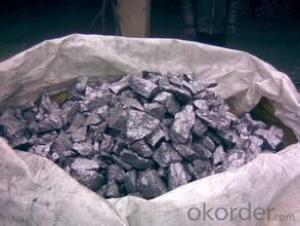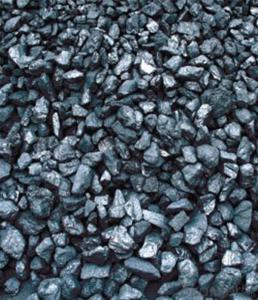Carbon Additve FC 90-95% Specifications
- Loading Port:
- Tianjin
- Payment Terms:
- TT or LC
- Min Order Qty:
- 20 m.t.
- Supply Capability:
- 10000 m.t./month
OKorder Service Pledge
OKorder Financial Service
You Might Also Like
Quick Details
Place of Origin: Ningxia, China (Mainland)
Application: steel making
Shape: granule
Dimensions: FC90-95%
Product Type: Carbon Additive
C Content (%): 90-95% MIN
Working Temperature: -
S Content (%): 0.5%MAX
N Content (%): -
H Content (%): 0.6%MAX
Ash Content (%): 8.5%MAX
Volatile: 2%MAX
ADVANTAGE: low ash & sulfur
COLOR: Black
RAW MATERIAL: TaiXi anthracite
Packaging & Delivery
| Packaging Details: | In 1MT plastic woven bag. |
|---|---|
| Delivery Detail: | 30-40DAYS |
Specifications
Carbon Additve FC 90-95% Specifications
Carbon Additve low Ash,S,P
FC>95% ASH<4% S<0.3%
It is made from TaiXi anthracite.
instead of pertrol coke reduce the cost
Structure
Carbon Additve FC 90-95% Specifications
Shape: granule
Dimensions: FC90-95%
Product Type: Carbon Additive
C Content (%): 90-95% MIN
Working Temperature: -
S Content (%): 0.5%MAX
N Content (%): -
H Content (%): 0.6%MAX
Ash Content (%): 8.5%MAX
Volatile: 2%MAX
ADVANTAGE: low ash & sulfur
COLOR: Black
RAW MATERIAL: TaiXi anthracite
Feature
Carbon Additve FC 90-95% Specifications
Specifications (%): | ||||||
Grade | F.C | Ash | V.M | Moisture | S | Size |
CR-95 | ≥95 | <4 | <1 | <1 | <0.3 | 0-30mm |
CR-94 | ≥94 | <4 | <1 | <1 | <0.3 | |
CR-93 | ≥93 | <6 | <1 | <1 | <0.4 | |
CR-92 | ≥92 | <7 | <1 | <1 | <0.4 | |
CR-91 | ≥91 | <8 | <1 | <1 | <0.4 | |
CR-90 | ≥90 | <8.5 | <1.5 | <2 | <0.4 | |
Image
Carbon Additve FC 90-95% Specifications
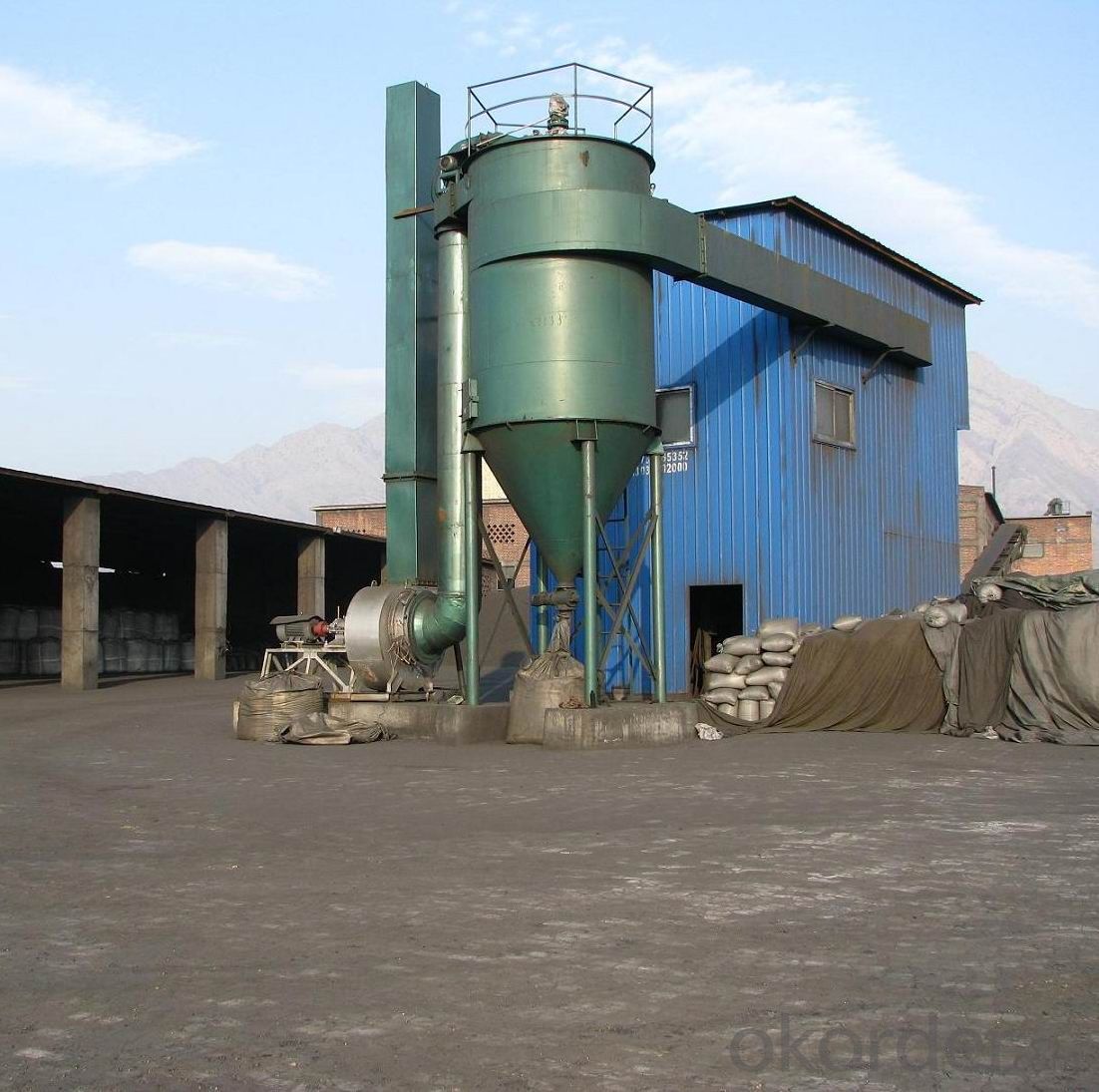
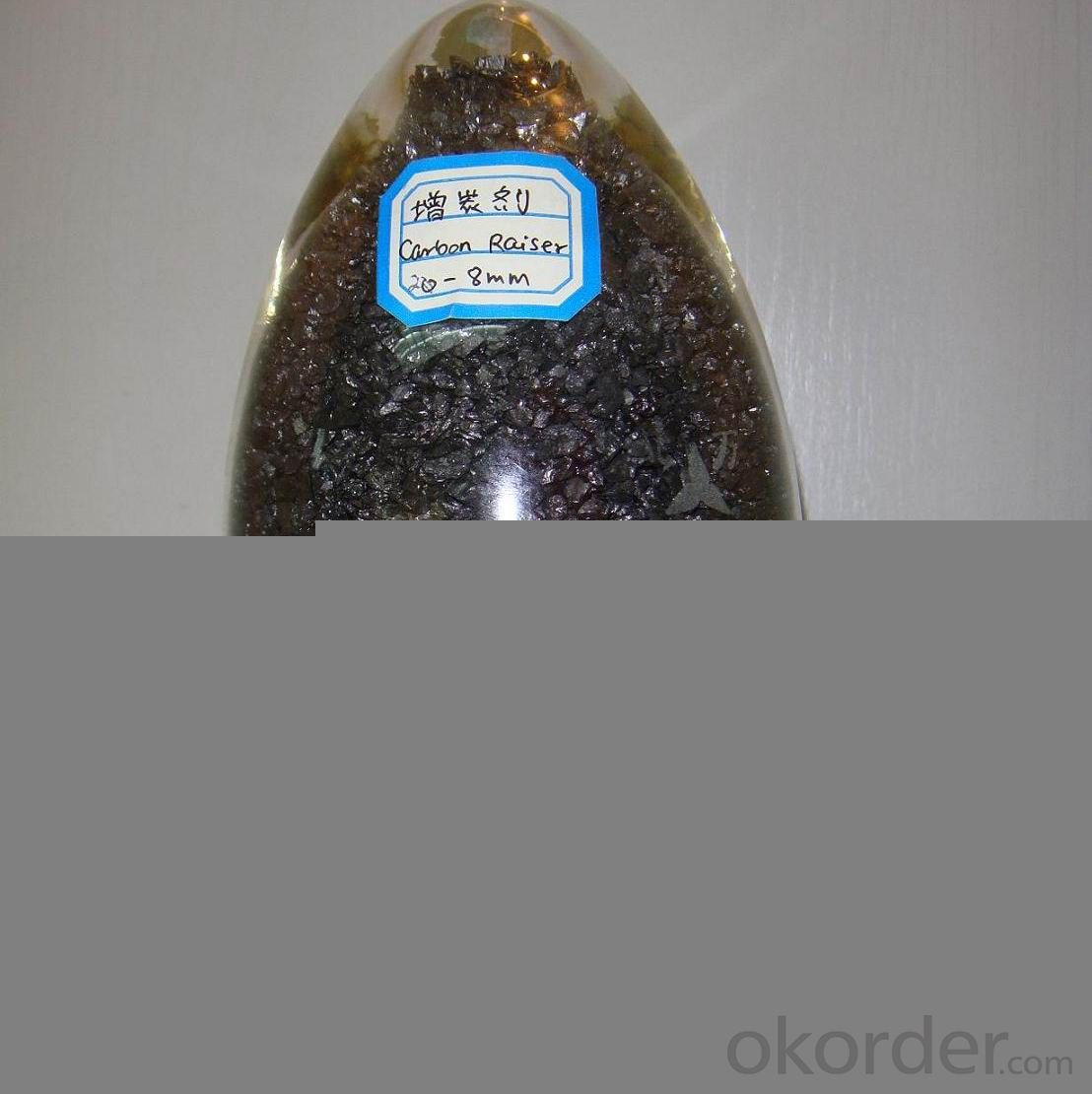
FAQ:
Carbon Additve FC 90-95% Specifications
Why we adopt carbon additive?
Carbon Additives used as additive in steel making process. It made from well-selected Tai Xi anthracite which is low in content of ash, sulphur, phosphorus, high heat productivity, high chemically activation.
Mainly industry property of it is: instead of traditional pertroleum coal of Carbon Additives, reduce the cost of steelmaking.
Advantage:
Carbon Additve FC 90-95% Specifications
1.High quality and competitive price.
2.Timely delivery.
3.If any item you like. Please contact us.
Your sincere inquiries are typically answered within 24 hours.
- Q: How does carbon impact the availability of natural resources?
- Carbon, in the form of carbon dioxide (CO2), has a significant impact on the availability of natural resources. The burning of fossil fuels, such as coal, oil, and natural gas, releases large amounts of carbon dioxide into the atmosphere. This excessive release of CO2 is responsible for the greenhouse effect, leading to global warming and climate change. One of the most significant effects of climate change is the alteration of natural habitats and ecosystems. Rising temperatures and changing weather patterns directly impact the availability of various natural resources. For instance, higher temperatures can lead to the melting of glaciers and ice caps, affecting the availability of freshwater resources for human consumption and agriculture. Additionally, carbon emissions contribute to the acidification of oceans, which has detrimental effects on marine life. Coral reefs, for example, are highly sensitive to changes in water chemistry, and increased acidity due to elevated CO2 levels can result in their bleaching and eventual death. This not only affects the biodiversity of the oceans but also impacts the availability of fish and other seafood resources that many communities rely on for sustenance and livelihoods. Furthermore, climate change caused by carbon emissions disrupts the balance of ecosystems, leading to the extinction or displacement of numerous plant and animal species. This can have cascading effects on the availability of resources such as timber, medicinal plants, and other valuable natural products sourced from forests and other ecosystems. Moreover, carbon emissions contribute to air pollution, which has detrimental effects on human health. High concentrations of airborne pollutants, including particulate matter, can lead to respiratory diseases and other health issues, exacerbating the strain on healthcare systems and reducing the productivity and overall well-being of communities. To mitigate the negative impacts of carbon emissions on the availability of natural resources, it is crucial to transition to cleaner and more sustainable energy sources, such as renewable energy. This shift would reduce the reliance on fossil fuels and subsequently decrease carbon emissions, helping to preserve and protect our natural resources for future generations.
- Q: How do forests act as carbon sinks?
- Forests act as carbon sinks by absorbing carbon dioxide from the atmosphere through the process of photosynthesis. Trees and other plants take in carbon dioxide and convert it into oxygen, while storing the carbon in their trunks, branches, and roots. This stored carbon remains in the forest ecosystem, reducing the amount of greenhouse gases in the atmosphere and helping to mitigate climate change.
- Q: Yes, I have a weapon, want to strengthen 11, said to be advanced furnace rock carbon, do not know how to get, look at the prawns pointing
- Pro, tell you an unfortunate news, out of the eighty furnace rock carbon, old horse recycling, burning their own boilers, and now we strengthen the use of colorless small crystal block, that is, the colorless small crystal block instead of the original furnace rock carbon.
- Q: How does carbon dioxide contribute to ocean acidification?
- Carbon dioxide contributes to ocean acidification through a process called carbonic acid formation. When carbon dioxide dissolves in seawater, it reacts with water molecules to form carbonic acid. This reaction increases the concentration of hydrogen ions in the water, leading to a decrease in pH, making the water more acidic. As carbon dioxide emissions from human activities, particularly the burning of fossil fuels, continue to increase, more and more carbon dioxide is being absorbed by the oceans. This excessive absorption is disrupting the natural equilibrium that exists between carbon dioxide in the atmosphere and in the ocean, resulting in a surplus of carbon dioxide in the seawater. The increased acidity of the seawater can have severe consequences for marine life. Many marine organisms such as corals, shellfish, and certain types of plankton depend on calcium carbonate to build their shells or skeletons. However, in more acidic water, the availability of carbonate ions, which are necessary for the formation of calcium carbonate, decreases. As a result, these organisms struggle to build and maintain their protective structures, making them more vulnerable to predation and other threats. Ocean acidification also affects the growth, development, and behavior of many other marine species. For instance, acidification can disrupt the reproductive cycles of fish and alter the behavior of some species, making them more prone to predation or negatively impacting their ability to find food or mates. Furthermore, ocean acidification can have cascading effects on entire marine ecosystems. Many species in the ocean are interconnected in complex food webs, and any disruption to one species can have far-reaching consequences on others. For example, if the population of a certain fish species declines due to the impacts of acidification, it can have a ripple effect on the entire food chain, affecting the abundance and distribution of other species. In summary, carbon dioxide contributes to ocean acidification by dissolving in seawater and forming carbonic acid, which increases the concentration of hydrogen ions and decreases the pH. This process can have detrimental effects on marine organisms, particularly those that rely on calcium carbonate for their shells or skeletons. It can also disrupt the growth, development, and behavior of various marine species and have cascading impacts on entire ecosystems.
- Q: What are the advantages of carbon-based solar cells?
- There are several advantages of carbon-based solar cells that make them a promising technology for renewable energy production. Firstly, carbon-based solar cells are lightweight and flexible, which makes them highly versatile in terms of deployment options. They can be integrated into various surfaces, such as building facades, windows, or even clothing, expanding the possibilities for solar energy generation. Secondly, carbon-based solar cells have a low environmental impact compared to traditional silicon-based solar cells. The production process of carbon-based solar cells usually involves less energy consumption and fewer toxic materials, reducing the overall carbon footprint of the technology. Additionally, carbon-based solar cells have a shorter energy payback time, meaning they reach the point of generating more energy than it takes to produce them faster than silicon-based solar cells. Another advantage of carbon-based solar cells is their potential for low-cost manufacturing. Carbon-based materials, such as organic polymers or perovskites, can be produced through cost-effective techniques like solution processing or printing methods. This scalability and affordability make carbon-based solar cells an attractive option for large-scale deployment, which can help accelerate the global adoption of solar energy. Furthermore, carbon-based solar cells have the potential for improved performance in low-light conditions. Due to their unique properties, such as the ability to absorb a broader range of light wavelengths, they can generate electricity even in cloudy or indoor environments. This makes carbon-based solar cells suitable for a wider range of applications, including indoor electronics, wearable devices, or even integration into urban infrastructure. Lastly, the biodegradability of some carbon-based materials used in solar cells makes them more environmentally friendly. As the world moves towards a circular economy and strives for sustainable solutions, the ability to recycle or dispose of solar cells without causing harm to the environment becomes increasingly important. In summary, carbon-based solar cells offer advantages such as flexibility, low environmental impact, low-cost manufacturing, improved performance in low-light conditions, and biodegradability. These advantages make them a promising technology for realizing a sustainable and widely accessible solar energy future.
- Q: When is gold resistance better? When will carbon resistance be better?
- Metal film resistance, high precision, overload capacity, high temperature coefficient, but the price is also higher. Commonly used in some demanding or more accurate circuit, such as instrumentation, precision power supply. Carbon film resistors have high cost performance and low cost, but they have larger errors. A large number of applications in civil electrical products. Such as television, air conditioning, stereo and so on.
- Q: How do you use carbon fourteen to measure the age?
- One is obvious a small amount of sample, only 1 ~ 5 mg samples can be, such as a piece of fabric, bone chips, toner trace of ancient ceramics in the surface or pores can be measured; while the conventional carbon - 14 dating rules 1 to 5 grams of samples differ by 3 orders of magnitude. The two is high sensitivity. The sensitivity of 10-15 to 10-16 isotope ratio measurement; while the conventional carbon - 14 dating rules with a difference of 5 to 7 orders of magnitude. Three is a short measurement time, measurement of modern carbon to reach 1% accuracy, only 10 to 20 minutes; while the conventional carbon - 14 dating is 12 ~ 20 hours. It is due to carbon - 14 accelerator mass spectrometry dating method has the advantage, since its inception, has been paid attention to by archaeologists, paleontologists and geologists, and is widely used. It can be said that within 50000 years of cultural relics on the determination of samples, carbon - 14 accelerator mass spectrometry dating method is determined the accuracy of a maximum of 1. carbon. 14 is a radioactive isotope of carbon, was found in 1940. It is produced by cosmic rays collide with a nitrogen atom in the air, which has a half-life of about 5730 years, as the decay of beta decay, 14 atoms into carbon nitrogen atoms.
- Q: How does carbon affect the properties of steel?
- Carbon affects the properties of steel by increasing its hardness, strength, and overall durability. The presence of carbon allows for the formation of iron carbides, which strengthen the steel's crystal lattice structure. The higher the carbon content, the harder and stronger the steel becomes. However, excessive carbon can make the steel brittle, reducing its impact resistance.
- Q: What is the boiling point of carbon?
- The boiling point of carbon is approximately 4,827 degrees Celsius (8,740 degrees Fahrenheit).
- Q: What are the different types of carbon-based air pollutants?
- There are several types of carbon-based air pollutants, including carbon monoxide (CO), carbon dioxide (CO2), volatile organic compounds (VOCs), and black carbon (BC).
Send your message to us
Carbon Additve FC 90-95% Specifications
- Loading Port:
- Tianjin
- Payment Terms:
- TT or LC
- Min Order Qty:
- 20 m.t.
- Supply Capability:
- 10000 m.t./month
OKorder Service Pledge
OKorder Financial Service
Similar products
Hot products
Hot Searches
Related keywords
